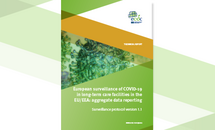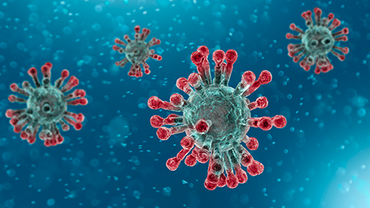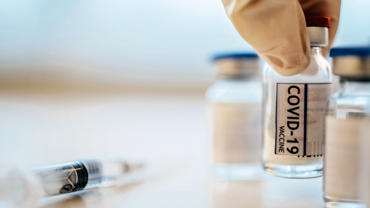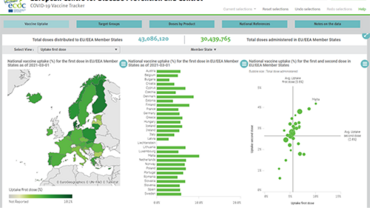Generic protocol for ECDC studies of COVID-19 vaccine effectiveness against confirmed SARS-CoV-2 using healthcare worker cohorts, version 3.0
This generic protocol for ECDC studies describes the design and methods for a prospective multi-country cohort study of hospital-based healthcare workers (HCWs) to evaluate the effectiveness of COVID-19 vaccine in preventing laboratory-confirmed SARS-CoV-2 infection.
Executive Summary
The end of 2019 saw the emergence of a novel severe acute respiratory syndrome: coronavirus 2 (SARS-CoV-2), which causes coronavirus disease 2019 (COVID-19).
As of December 2023, eight vaccines (Comirnaty, Spikevax, Vaxzevria, Jcovden Valneva, Nuvaxovid, VidPrevtyn, and Bimervax) have been authorised for use in the European Union (EU) by the European Commission, based on the scientific opinion of the European Medicines Agency (EMA). Updated formulations of Comirnaty and Spikevax to protect against the original and BA.4-5 strains were authorised in 2022. Adapted versions using the Omicron XBB.1.5 strain were authorised on 31 August (Comirnaty), 15 September (Spikevax), and 31 October (Nuvaxovid) 2023 [1].
In 2020, the European Commission emphasised the importance of continuously monitoring the safety and effectiveness of vaccines in the EU/EEA and called on ECDC and EMA to develop a structured post-authorisation monitoring platform for vaccines, prioritising COVID-19 vaccines. In November 2020, the European Commission proposed to the European Parliament and the Council of the EU a change to the mandates of EMA and ECDC in the context of its COVID-19 lessons learned package and the creation of a European Health Union, empowering the two agencies to jointly coordinate independent vaccine monitoring studies.
As a result, at the end of 2020, utilising the lessons learned from other vaccine effectiveness studies, ECDC started building infrastructure to perform COVID-19 vaccine effectiveness studies. The infrastructure aims to build a system to regularly monitor vaccine effectiveness and perform studies in different settings, and depending on the setting, to provide information on different outcomes (severe disease, moderate disease, infection, transmission, etc). The studies have been embedded in a project called VEBIS (Vaccine Effectiveness, Burden and Impact Studies).
This generic protocol describes the design and methods for a prospective multi-country cohort study of hospital- based healthcare workers (HCWs) to evaluate the effectiveness of COVID-19 vaccines in preventing laboratory- confirmed SARS-CoV-2 infection. The combination of data from multiple sites aims at providing sufficient statistical power to meet both the overarching primary objective and a range of more specific secondary objectives. This protocol has been adapted to the rapid vaccine roll-out for COVID-19 in many countries and accommodates the establishment of HCW cohorts subsequent to the implementation of vaccination programmes.
All HCWs eligible to be vaccinated with COVID-19 vaccines can be enrolled in the study, including those who have already been vaccinated with a primary COVID-19 vaccination course, those that have received booster dose(s), those who intend or do not intend to be vaccinated and those who are not sure. At enrolment, study participants complete a baseline enrolment survey about demographics, clinical comorbidities, and work- and community-related behaviours related to infection risk. In addition, a baseline serology sample and a respiratory specimen should be collected from participants.
During the course of the study, participants should be actively followed for suspected SARS-CoV-2 infection through regular monitoring:
- Molecular testing: participants should provide a weekly sample, either a nasopharyngeal, nasal or oropharyngeal swab collected by trained HCWs (or self-swab following training) or a self-taken saliva sample, which should be tested for SARS-CoV-2 by RT-PCR. Site investigators should select for genetic sequencing all or a representative proportion of SARS-CoV-2 confirmed infections in participants.
- Questionnaire survey: participants should complete a weekly survey reporting the occurrence of any COVID-19-related symptoms and any changes in high-risk exposures to infection (both professional and in the community).
- Serology: serum samples should be collected at enrolment and thereafter every 12 weeks (three samples during the winter season) from participants. Serum samples should be tested for antibodies against SARS-CoV-2 by serological testing algorithms that can distinguish between vaccine-induced and infection-induced antibodies.
This protocol is primarily intended to guide the implementation of ECDC-funded studies. However, ECDC encourages the active endorsement and implementation of this protocol also beyond ECDC-funded studies to strengthen the evidence base for future policy decisions. The use of consistent protocols will facilitate the comparability of study results across studies, countries, and study sites.
The second version of the protocol included the lessons learnt from the studies performed until end of July 2022, comments from the site investigators and recommendations from the first technical meetings of the VEBIS HCW project. This updated version 3.0 includes recommendations for COVID-19 surveillance after the pandemic phases as well as recommendations from participating sites until end of May 2023.
Changes in version 3.0
The main changes in this version compared to version 2.0 include data collection on clinical characteristics to reconstitute the acute respiratory infection (ARI) and influenza-like illness (ILI) case definitions according to the current recommendations for respiratory diseases surveillance, and additional clarifications on serology data collection section and community exposures, as well as additional analyses: restrictions by circulation of different sub-lineages of Omicron VOC, relative vaccine effectiveness analysis comparing the second and first booster doses and first booster dose and primary course, adjusted analysis and inclusion of re-infections. The second version of this protocol (see version 2.0) was used until 21 May 2023.
Download








